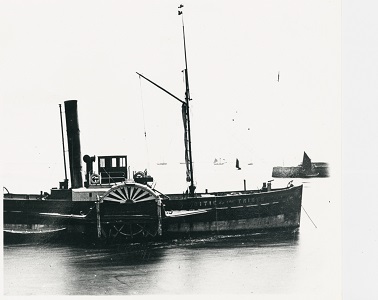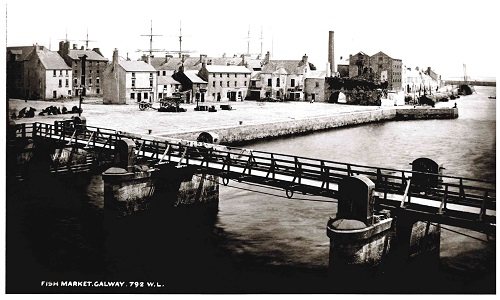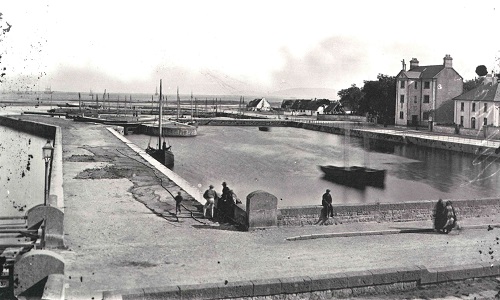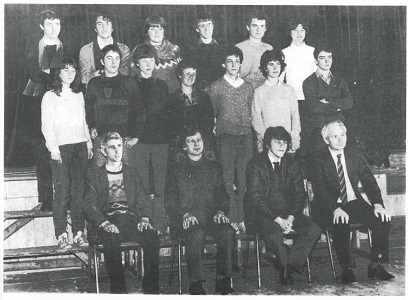Old Galway
STEAMBOATS COME TO GALWAY

by Tom Kenny
One hundred and fifty years ago, on the 17th of August 1672, the paddle steamer Citie of the Tribes was launched in South Shields in England. She was built by J.T. Eltringham, weighed 117 gross tons and was registered for the Galway Bay Steamboat Company. Her arrival in the docks caused great excitement. She was hailed as heralding a new future for shipping in the west, the age of steam! She was the only steamboat in Galway, a paddle tug about 96’ x 18’ x 9’, and as you can see from her schedule for July 1875 printed here, she was a busy vessel. On the days not listed, she travelled on excursions or to Aran.
INIS CAORACH, MUTTON ISLAND

by Tom Kenny
In the year 1124, the town was put in a state of security and a strong castle was built at Dún Bun na Gaillimhe (the fortification at the mouth of the Galway River). Several times in the next century, the Kings of Munster invaded Connacht bringing death and destruction and usually destroying the town and the buildings on the island. In 1190, there is a reference to Lismacuan, ‘The fort on the Mouth of the Harbour’.
In 1641, an order was made that the islands of Mutton Island, approximately 3 acres, were to be made use of as a commonage by the inhabitants of Galway and the Liberties thereof. From a military point of view, the island was of great strategic importance. When the city was under siege in 1651 “The enemie…. Caused some Parliament vessels to anchor on Galway’s harbour, and to land some men on Sheepe Island to master the towns from them: with his ordnance very commodious, the number four score and ten choice mariners and other lustie men were then landed, to build half moones, redoubts and other inginier-works, to mount their artillerie against the towne …. The worke was begun, which if finished, doubtless the towne could not subsiste”.
WOLFE TONE BRIDGE

by Tom Kenny
Wolfe Tone Bridge was the third bridge to be built over the river. The West Bridge (now known as O’Brien’s Bridge) was the first and dates from medieval times. The Salmon Weir Bridge dates from 1820 and the Wolfe Tone Bridge was built in the mid-nineteenth century.
In olden times the fish market used to be on Bridge Street and then they moved it to Spanish Parade. This meant a long roundabout walk for the main suppliers to the market, Claddagh fisherwomen, so they protested to the authorities and eventually, the bridge was constructed, allowing them easy access to the fishmarket. It was named after Theobald Wolfe Tone, the famous republican revolutionary who was one of the founders of the United Irishmen. He fought in a number of military engagements against the British Navy. He was captured in 1798 while trying to land French troops and supplies in Ireland and he was sentenced to death. He took his own life before they could carry it out. He is regarded as the father of Republicanism in Ireland.
The construction of the Claddagh Basin

by Tom Kenny
On January 1, 1848, Samuel U Roberts was appointed district engineer of the Districts of Lough Corrib. He spent the early part of that year making necessary preparations and arrangements and started navigational works in Galway on March 8, having taken possession of some of the lands required for the Eglinton Canal.
In a report to the Board of Public Works in 1848, he wrote of the start of the work on the Claddagh Basin: “A large quantity of ashlar stone has been prepared for the lock and tidal basin works in connexion with the canal and some stanks have been formed with a view to carrying on the work as easily as the approaching season will permit.”
THE CLASS OF ‘82

by Tom Kenny
One hundred and sixty years ago, in 1862, the Jesuits opened the doors of St. Ignatius College on Sea Road for the first time. They also opened a Community residence and a church at the same time. To take on such an ambitious building project at a time when the economic state of the country was so bad took courage and vision.
The move to Sea Road was a success, attendances at mass and ceremonies grew rapidly, confessions sometimes went on until midnight. The College, however, was more of a challenge. The numbers at first were as expected, grew steadily to 90 in 1865 and reached 110 in 1874, but they began to fall thereafter and were inconsistent from year to year. In 1899 there were 49 pupils in the school. Numbers were low but academic standards were high. Things improved a little in the early 1900s but social, economic and political challenges in the 1920s saw a new decline in numbers and by 1924 there were only 67 boys on the rolls. Two years later, it was decided to close the school.
THE MODEL SCHOOL

by Tom Kenny
The Model School on Newcastle Road was built in 1849/50 for a cost of £2,533 plus £800 for the furniture. It was one of a series of Model Schools built around that time and was the only one constructed under budget. It opened in July 1852, 170 years ago this month. It catered for Protestant children.
In 1904, the Chief Secretary of Ireland, Mr. Wyndham, declared in Parliament that the average attendance in the school for the year 1903 was 95 and the expenditure out of public funds was £482. 11s.
THE BOYS’ CLUB

by Tom Kenny
“There is nothing as Galway as Our Lady’s Boys’ Club,” was how our president Michael D. Higgins described OLBC some years ago at a function in the Columban Hall. It is over 80 years since it was founded and it is the longest-running youth club in the country. It was set up by Fr. Leonard Shiel S.J. at a time when there was a lot of grinding poverty in Galway and no recreational facilities or extra-curricular activities for young people in areas like the Claddagh, Bohermore, Shantalla and ‘The West’. The club provided these and has been a source of guidance and inspiration to thousands of young men and boys since, especially those from working-class background. From that first day of nervous membership, right through their teens, and even after they had taken up the challenge of adult life, the spirit and watchful eye of the Club is ever with them.
THE BISH

by Tom Kenny
The Patrician Brothers, at the invitation of the last Catholic Warden of Galway, arrived in Galway in 1826 and a month later they opened St. Patrick’s Monastery and School on Market Street. They initially had 200 pupils but this figure rapidly grew so that during the Famine, there were over 1,000 boys being educated, fed and many of them clothed there every day. The school was a major success but there were no educational facilities for older boys in the ‘lower orders’ in Galway so Bishop McEvilly invited the Patrician Brothers to set up a secondary school.
.png)